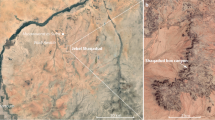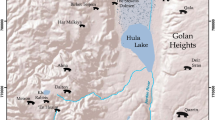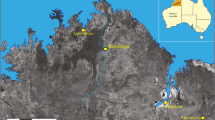Abstract
This archaeological study reveals previously undocumented rock art along the Blue Nile on the walls of the Buahit Serit gorge in the East Gojjam Zone of the Amhara Regional State in Northwestern Ethiopia. Although Ethiopia has the largest number of documented rock art sites in the Horn of Africa, Buahit Serit is the first published rock art site in the Amhara Regional State. The Buahit Serit rock art is tentatively dated to the late Holocene (1000 BCE–1000 CE) based on comparison of the content and style of its paintings. The rock paintings are composed of hunting, herding, and geometric representations. This study introduces the idea that some of the geometric designs may represent stylized headrest, which may connect the rock art to cultural continuity with living pastoralists. Today the Buahit Serit rock paintings, like many Ethiopian rock art sites, are endangered due to anthropogenic and natural causes.
Résumé
Cette étude archéologique met en lumière un art rupestre n'ayant pas auparavant été documenté le long du Nil bleu sur les falaises de la gorge de Buahit Serit de la région orientale de Gojjam de l'État régional d'Amhara dans la partie nord-ouest de l'Ethiopie. Bien que l'Ethiopie soit dotée du plus grand nombre de sites d'art rupestre documentés dans la Corne de l'Afrique, Buahit Serit est le premier site d'art rupestre publié dans l'État régional d'Amhara. L'art rupestre de Buahit Serit est provisoirement daté de la fin de l'Holocène (1000 av. J.-C. - 1000 de notre ère) en tenant compte de la comparaison du contenu et du style de ses peintures. Les peintures rupestres se composent de scènes de chasses, de troupeaux et de représentations géométriques. L'étude présente l'idée que certains des dessins géométriques peuvent représenter un appui-tête stylisé, pouvant connecter l'art rupestre à une continuité culturelle avec les gardiens de troupeaux actuels. De nos jours, les peintures rupestres de Buahit Serit, comme beaucoup de sites d'art rupestre éthiopiens, sont en péril en raison de causes naturelles et anthropomorphiques.
Resumen
Este estudio arqueológico revela arte rupestre previamente indocumentado a lo largo del Nilo Azul en las paredes del desfiladero de Buahit Serit en la Zona Este de Gojjam del Estado Regional de Amhara en el noroeste de Etiopía. Aunque Etiopía tiene el mayor número de sitios de arte rupestre documentados en el Cuerno de África, Buahit Serit es el primer sitio de arte rupestre publicado en el estado regional de Amhara. Se ubica el arte rupestre de Buahit Serit tentativamente en el Holoceno tardío (1000 a. C. - 1000 d. C.) en función de la comparación del contenido y el estilo de sus pinturas. Las pinturas rupestres consisten de representaciones geométricas, de caza y de pastoreo. Este estudio introduce la idea de que algunos de los diseños geométricos pueden representar un reposacabezas estilizado, lo que puede conectar el arte rupestre a la continuidad cultural con los pastores vivos. Hoy en día, las pinturas rupestres de Buahit Serit, como muchos sitios de arte rupestre de Etiopía, están en peligro debido a causas antropomórficas y naturales.



















Similar content being viewed by others
References
Abawa, G. (2014). Archaeological fieldwork around Lake Tana area of northwest Ethiopia and the implication for an understanding of aquatic adaptation. Ph.D. Dissertation. University of Bergen.
Abbink, J. (2015). Extensions of the self: Artistry and identity in the headrests and stools of southwest Ethiopian peoples. African Art, 48(4), 46–59.
Abera, J. (2003). Bälay Zälläqä. In Uhlig, S. (Ed.), Encyclopedia Aethiopica (Vol.1, p. 456).
Agnew, N., Deacon, J., Hall, N., Little, T., Sullivan, S., & Taçon, P. (2015). Rock Art. A cultural treasure at Ris. Los Angeles: The Getty Conservation Institute.
Aklilu, A. (2015). A study of the rock art of Shephe for eco-tourism and sustainable development. MA Thesis. Addis Ababa University.
Anfray, F. (1982). Les stèles du Sud, Shoa, et Sidamo. Annales d’Éthiopie, 12, xx–xx.
Anfray, F. (1967). Les sculptures rupestres de Chabbe dans le Sidamo. Annales d’Éthiopie, 7, 19–32.
Asfawossen, A. (2002). Introduction to geology. Addis Ababa University Press.
Assefa, Z., Pleurdeau, D., Duquesnoy, F., Hovers, E., Pearson, O., Asrat, A., & Lam, Y. M. (2014). Survey and explorations of caves in southeastern Ethiopia: Middle Stone Age and Later Stone Age archaeology and Holocene rock art. Quaternary International, 343, 136–147.
Azaïs, R. P., & Chambard, R. (1931). Cinq Annés de Recherches Archéologiques en Ethiopia. Paris: Geuthner.
Bailloud, G. (1963). La Préhistorie de l’Ethiopie. Tarik, 2, 33–35.
Barnett, T. (1999). The emergence of food production in Ethiopia. Cambridge Monographs in African Archaeology 45, BAR International Series S763. Oxford: Archaeopress
Beke, C. (1844). Abyssinia. Being a continuation of routes in that country. Royal Geographical Society of London, 14, 1–76.
Bouakaze-Khan, D., & Poisblaud, B. (2000). Art rupestre et Néolithique de l’Éthiopie. Découvertes récentes. Annales d’Ethiopie, 16(1), 39–53.
Brandt, S., & Carder, N. (1987). Pastoral rock art in the Horn of Africa: Making sense of udder chaos. World Archaeology, 1(2), 194–213.
Brandt, S. (1984). New perspectives on the origins of food production in Ethiopia. In J. D. Clark & S. Brandt (Eds.), From hunters to farmers: The causes and consequences food production Africa (pp. 173–190). Berkeley: University of California Press.
Brandt, S. (1982). Late quaternary cultural/environmental sequence from Lake Beseka, Southern Afar, Ethiopia. Ph.D. Dissertation. University of California, Berkeley.
Breuil, H. (1934). Peintures rupestres préhistoriques du Harrar (Abyssinie). Comptes rendus des séances de l’Académie des Inscriptions et Belles-Lettres, 78(2), 225–230.
Bruce, J. (1964 reprint 1770). Travel to discover the source of the Nile. Vol. III. Edinburgh: Edinburgh University Press.
Červíček, P. (1979). Some African affinities of Arabian rock art. Rassegna di Studi Etiopici, 27, 5–12.
Červíček, P. (1971). Rock paintings of Laga Oda (Ethiopia). Paideuma, 17, 121–136.
Červíček, P., & Braukämper, U. (1975). Rock paintings of Laga Gafra (Ethiopia). Paideuma, 21, 47–60.
Chane, S. (2019). The military organization and strategies of the patriots under the leadership of Dejazmach Belay Zeleke. The Ethiopian Journal of Social Sciences, 5(2), 3–23.
Chaix, L. (2013). The fauna from the UNO/BU excavations at Bieta Giyorgis (Aksum) in Tigray, northern Ethiopia: Campaigns 1995–2003; Pre-Aksumite, 700–400 BC to Late Aksumite, Ad 800–1200. Journal of African Archaeology, 11(2), 211–241.
Clark, J. D. (1945). Short notes on Stone Age sites at Yavello, southern Abyssinia. Transactions of the Royal Society of South Africa, 31(1), 29–37.
Clark, J. D. (1980). The origins of domestication in Ethiopia. In R. E. F. Leakey & B. A. Ogot (Eds.), Proceedings of the eighth Panafrican congress of prehistory and quaternary studies (pp. 268–70). Nairobi: The International Louis Leakey Memorial Institute for African Prehistory.
Clark, J. D. (1976). The domestication process in sub-Saharan Africa with special reference to Ethiopia. In E. Higgs (Ed.), Origine de l’Elevage et de la Domestication (pp. 56–115). Nice: IXth Congress IUSPP.
Clark, J. D. (1954). The prehistoric cultures of the Horn of Africa.
Clark, J. D., & Prince, R. (1978). Use-wear on Later Stone Age microliths from Lega Oda, Hararghi, Ethiopia and possible functional interpretations. Azania, 13, 101–110.
Dombrowski, J. (1971). Excavations in Ethiopia: Lalibela and Natchabiet Caves, Begemeder Province. PhD. Dissertation. Boston University.
Dombrowski, J. (1970). Preliminary report on excavations in Lalibela and Natchabiet Caves, Begemeder. Annales d’Éthiopie, 8, 21–29.
Ehret, C. (1979). On the antiquity of agriculture in Ethiopia. Journal of African History, 20, 161–177.
Finneran, N. (2007). The archaeology of Ethiopia. London: Routledge.
Gallinaro, M., Zerboni, A., Solomon, T., & Spinapolice, E. E. (2018). Rock art between preservation, research and sustainable development—A perspective from southern Ethiopia. African Archaeological Review, 35(2), 211–223.
Gebeye, B. (2016). Unsustain the sustainable: An evaluation of the legal and policy interventions for pastoral development in Ethiopia. Research Policy and Practice, 6, 1–14.
Graziosi, P. (1964). New discovery of rock paintings in Ethiopia. Antiquity, 38, 91–98.
Hagos, T. (2011). The Ethiopian rock art: The fragile resources. Addis Ababa: Authority for Research and Conservation of Cultural Heritage.
Hundie, G. (2001). The emergence of prehistoric pastoralism in southern Ethiopia. PhD Dissertation. University of Florida
Insoll, T., Clack, T., & Rege, O. (2015). Mursi ox modification in the Lower Omo Valley and the interpretation of cattle rock art in Ethiopia. Antiquity, 89(343), 91–105.
Joussaume, R. (1981). L ’Art Rupstre De L’Éthiopie. In C. Roubet, H. Hugot, & G. Souville (Eds.), Préhistoire Africaine: Mélanges Offerts Au Doyen Lionel Balout (pp. 159–174). Paris: Association des publications chauvinoises.
Joussaume, R., (Ed.). (1995). Tiya- l’Éthiopie des Mégalithes: Du biface à l’art rupestre dans la Corne de l’Afrique. Poitiers: P. Oudin.
Khalidi, L., Mologni, C., Ménard, C., Coudert, L., Gabriele, M., Davtian, G., Cauliez, J., Lesur, J., Bruxelles, L., Chesnaux, L., Redae, B., Hainsworth, E., Doubre, C., Revel M., Schuster, M., & Zazzo, A. (2020). 9000 years of human lakeside adaptation in the Ethiopian Afar: Fisher-foragers and the first pastoralists in the Lake Abhe basin during the African Humid Period. Quaternary Science Reviews, 243, 106459.
Le Quellec, J., Abegaz, G. (2001). New sites of South Ethiopia rock engravings: Godana Kinjo, Ejersa Gara Hallo, Lega Harro and remarks on the Shappe-Galma school. Annalesd’Ethiopie, XVII, 203–222.
Lesur, J., Hildebrand, E. A., Abawa, G., & Gutherz, X. (2014). The advent of herding in the Horn of Africa: New data from Ethiopia, Djibouti, and Somaliland. Quaternary International, 343, 148–158.
Lesur, J., Arthur, J. W., Arthur, K. W., & Curtis, M. C. (2018). Hide and meat among Boreda hideworkers: Ethnoarchaeozoology of consumption and craft practices in Gamo (southwest Ethiopia). Quaternary International, 471, 81–94.
Marshall, F. (1990). Origins of specialized pastoral production in East Africa. American Anthropologist, 92(4), 873–894.
Marshall, F., & Hildebrand, E. (2002). Cattle before food production in Africa. Journal of World Prehistory, 16, 99–143.
Marshall, F., & Weissbrod, L. (2011). Domestication processes and morphological change: Through the lens of the donkey and African pastoralism. Current Anthropology, 52(S4), S397–S413.
Meressa, G. (2006). Rock art sites in northeastern Ethiopia: The contribution to the development of early food production. MA Thesis. Addis Ababa University.
Mire, S. (2008). The discovery of Dhambalin Rock Art Site, Somaliland. African Archaeological Review, 25, 153–168.
Murdock, G. (1959). Africa: Its peoples and their culture History. New York: McGraw-Hill.
Negash, A. (2018). Regional variation of the rock art of Ethiopia: A geological perspective. African Archaeological Review, 35, 407–416.
Negash, A. (1997). Ethiopia and the Horn: Rock Art. In J. Vogel (Ed.), The encyclopedia of Pre- colonial Africa (pp. 357–361). London: Sage.
Negash, A. (2001). The Holocene prehistoric archaeology of the Temben region Northern Ethiopia. PhD. Dissertation. University of Florida.
Nettleton, A. (2007). African dream machines: Style, identity and meaning of African headrests. Johannesburg: Wits University Press.
Nigus, T. (2011). Pre-historic rock art of Garamuleta-Girawa massif Southeastern Ethiopia. Ph.D. Dissertation. University of Naples.
Nigus, T. (2005). Conservation of pre-historic rock art in the environ of Harar and Dire Dawa, southeastern Ethiopia. MA Thesis. Addis Ababa University.
Phillipson, D. (1977). The excavation of Gobedra rock shelter, Axum: An early occurrence of cultivated finger millet in Northern Ethiopia. Azania, 12, 53–82.
Rey, C. (1926). A recent visit to Gudru and Gojjam. The Geographical Journal, 67(6), 481–505.
Ricci, L. (1955). Ritrovamenti archeologici in Eritrea, II. Rassegna di Studi Etiopici, 15, 48–68.
Russell, T. (2013). Through the skin: Exploring pastoralist marks and their meanings to understand parts of East African rock art. Journal of Social Archaeology, 13(1), 3–30.
Sahle, Y., Giusti, D., Gossa, T., & Ashkenazy, H. (2019). Exploring karst landscapes: New prehistoric sites in south-central Ethiopia. Antiquity, 93(370), 1–6.
Simane, B., Zaitchik, B. F., & Ozdogan, M. (2013). Agroecosystem analysis of the Choke Mountain watersheds, Ethiopia. Sustainability, 5(2), 592–616.
Solomon, T. (2020). Understanding the beginning of herding through the study of rock art: The case of Borana in Southern Ethiopia. PhD Dissertation. Ferrara University.
Teilhard de Chardin, P. (1930). Le Paléolithique en Somalie française et en Abyssinie. L’Anthropologie, 40, 331–334.
Willcox, A. R. (1984). The rock art of Africa. London: Croom Helm.
Wright, D. (2011). Frontier animal husbandry in the Northeast and East African Neolithic: A multiproxy paleoenvironmental and paleodemographic study. Journal of Anthropological Research, 67(2), 213–244.
Acknowledgements
The Authority for Research and Conservation of Cultural Heritage is gratefully acknowledged for granting permission and encouraging me to publish the new discovery. I am indebted to the community at the rock art site for their hospitality and generosity during all my fieldwork; the coffee, local drinks, and food I was served in their modest homes were very tasty. I warmly thank my field guide Haymanot Talema, who introduced me to the study area and was constantly at my side in that unfamiliar environment. From the inception to the end of this work, Dr. Alemseged Beldados was behind me with his invaluable advice and professional support. Agazi Negash, Tekle Hagos, and Jeremy Hollmann all shared with me their precious time and the resources I requested. Christopher Tribe, Tania Tribe, Ethel Allue and Kathryn Arthur deserve a great thanks for their invaluable professional support in reviewing the manuscript. Catherine D’Andrea I warmly thank for her enthusiasm. I am most grateful to my colleague Hiruy Daniel for his unreserved effort in producing the drawings. I also thank Muluken Nega for preparing the study site map. To my dearest brother Keralem Wondyifraw, who once told me the very special and little-known local story about Belay Zeleke that prompted me to explore his area of origin to find out more, so that I ended up discovering this new rock art site, I give you my heartfelt thanks indeed.
Funding
Debre Markos University.
Author information
Authors and Affiliations
Corresponding author
Ethics declarations
Conflict of interest
The authors declare that they have no conflict of interest.
Additional information
Publisher's Note
Springer Nature remains neutral with regard to jurisdictional claims in published maps and institutional affiliations.
Rights and permissions
About this article
Cite this article
Tsegaye, T.W. Buahit Serit; A Newly Documented and Endangered Pastoral Rock Art Site in East Gojjam, Northwestern Ethiopia. Arch 17, 431–459 (2021). https://doi.org/10.1007/s11759-021-09431-0
Accepted:
Published:
Issue Date:
DOI: https://doi.org/10.1007/s11759-021-09431-0




